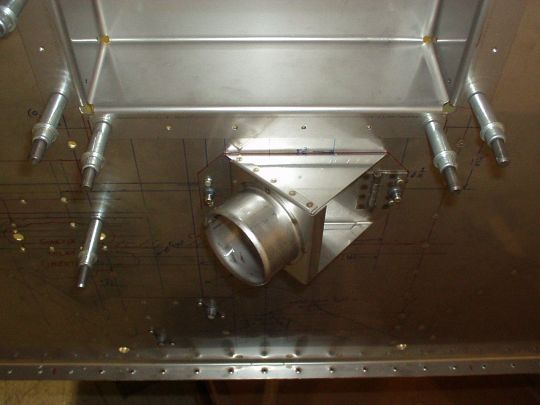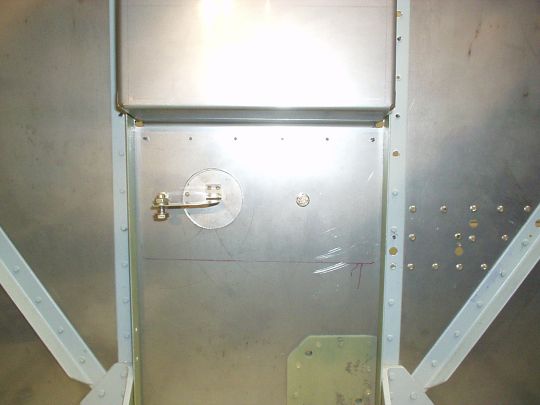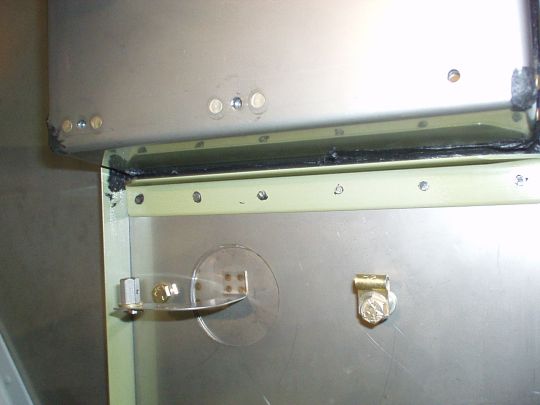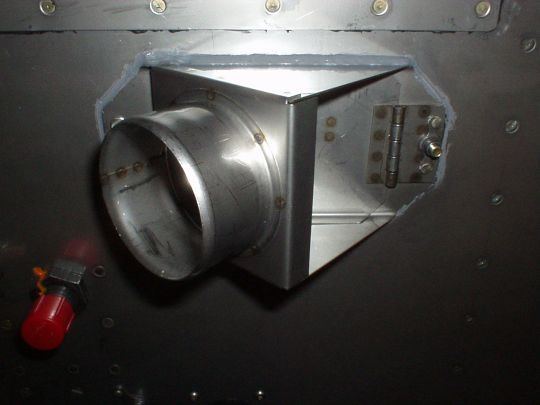|
  

Cabin Heat
 | 2010.12.21: (0.0)
Cabin heat is provided as follows. Air is taken from the high
pressure plenum through a 2" SCAT tube into a shroud that
surrounds one of the exhaust pipes, where the air is heated.
From there, the heated air is directed via another SCAT tube to the
cabin heat selector valve, mounted on the forward (engine) side of the
firewall. The selector valve can either direct the heated air
into the cabin (via a 2" hole in the firewall) or just vent it
into the low pressure plenum. The selector valve is controlled
by a push-pull cable on the aft (cabin) side of the firewall.
This arrangement seems reasonable, and reportedly provides adequate
heat except for in the coldest of climates (folks up in Canada often
route two heat shrouds in series in order to get enough heat).
Should be more than enough for SoCal.
One shortcoming however is that the selector valve provided by Van's
is made of aluminum, which would melt like butter in the event of an
engine fire. I opted to replace it with an after market selector
valve made of stainless steel. This is made by EPM.AVCORP and
sold by Avery (p/n 9882). It is more or less identical otherwise
to Van's p/n TG-10.
I fitted the selector valve to the firewall. Note that to cut
the 2" hole in the firewall I used a hydraulic punch set I
purchased from Harbor Freight (p/n 96718), same idea as a
"Greenly" punch, but at about 1/10 the cost.

 |
 | 2011.03.07: (0.0)
Did an initial fit-up of the control cable. Using a set
screw type B-nut (Aircraft Spruce p/n 05-16245) to secure the cable to
the control lever. I then secure the cable (Van's p/n ???, made
by ACS, p/n ???) sheath with a clamp at the starboard mounting bolt of
the selector, but deviating slightly from Van's configuration.
Instead of a rubber cushioned clamp I'm using an all- metal clamp (AN742-D3)
for heat resistance. And for better cable geometry, I added a
spacer between the clamp and the firewall: a 3/8" spacer from
hard aluminum tubing, sandwiched between two standard steel
washers. Moving up the cable... it then passes through a
3/16" hole directly through the upright firewall siffener, which
I drilled more-or-less at Van's suggested location. It then
makes a gentle turn up and gets secured to the diagonal firewall
stiffener with a cushioned clamp. It then turns aft and gets
secured to the big gusset with another cushioned clamp, via a small
angle bracket that I made. From there it travels straight aft
through the sub-panel and ultimately the instrument panel. I
haven't determined the exact instrument panel layout yet, so I haven't
drilled these holes. But I'm envisioning having this control at
the bottom right corner of the instrument panel, just to the left and
slightly above the co-pilot's fresh air vent. As it so happens,
running the cable through the tooling hole in the sub-panel actually
lines it up for this location almost perfectly.
After completing the cable fit-up, I permanently installed the
selector valve. Unlike the P/S 700 sealant used on the firewall
recess, here I used a different sealant, Rectorseal BioTherm 100
Firestop, which came with the selector valve. Apparently this
stuff held up to flame tests done by EPM.AVCORP (now Plane
Innovations, LLC) better than just about anything else. It
is also very easy to work with. It comes as a single component
in a 1/2 oz. squeeze tube (waaay more than needed), and is easily
applied like common RTV. I applied it to the mating surfaces
between the selector and firewall, and also made nice fillets at the
top and bottom after bolting them together. Came out nice.
This sealant cures to a fairly pliable rubber consistency. I'll
probably use this stuff if any more non-structural firewall sealing is
needed ($3/tube from Plane Innovations).

 |

  
|
|